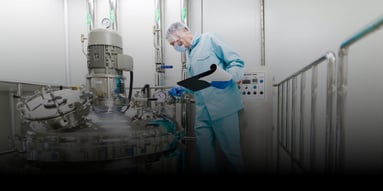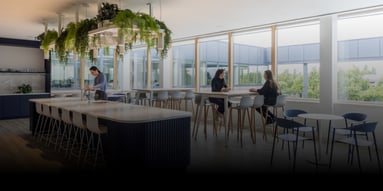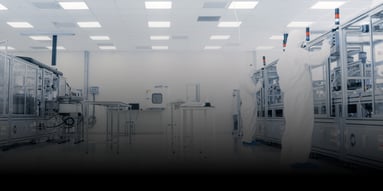How a design-build approach can fast-track life sciences construction projects
Life sciences companies are innovating and expanding at unprecedented rates. The facilities supporting this growth are highly complex, requiring both flexibility and strict adherence to rigorous quality standards. These projects are often propelled by urgent speed-to-market demands. The difference often lies in the approach. Enter design-build construction. Traditional construction methods often involve a fragmented approach: one entity designs, another builds. Design-build, on the other hand, is a holistic approach where one entity handles both the design and construction—it's a one-stop shop.
This approach isn't just beneficial for complex projects requiring tight coordination and innovative solutions—it's essential. Life sciences projects, such as laboratory designs, pharmaceutical manufacturing plants, and research facilities, can't afford to miss out on the immense advantages this method offers. It’s versatile, efficient, and effective.
Here's a look at its advantages:
1. Single point of responsibility
Having one entity responsible for both design and construction streamlines communication and coordination. This minimizes conflicts and enhances schedule adherence, cost management, and quality control while reducing administrative effort. Additionally, clients benefit from a single point of contact, which lowers the risk of disputes between the designer and builder and simplifies change management.
2. Flexibility and innovation
The design-build approach offers significant advantages in both flexibility and innovation. The collaborative nature of an integrated design-build team fosters innovation. Designers, life sciences experts, and builders work together to find creative solutions to complex problems. It allows for a more adaptive approach. If there are changes or unforeseen challenges, the team can quickly pivot and make necessary adjustments, ensuring the project stays on track.
3. Reduced risk and time efficiency
Life sciences projects must adhere to strict regulatory standards, and the design-build approach addresses these needs effectively. With a single entity responsible for the entirety of the project, there's a clear line of accountability. This means fewer chances for disputes, litigation, and financial surprises.
The overlap of design and construction phases can expedite the project. While the design team is working on the latter stages, the construction team can begin their work. This parallel process often leads to faster project delivery. 
4. Cost considerations
An integrated team approach often leads to more accurate initial estimates, particularly for life sciences projects with significant financial constraints. With early knowledge of costs, clients can make informed decisions sooner, leading to a better utilization of funds.
Additionally, the integrated nature of design-build teams allows for the effective identification of cost-saving opportunities without compromising quality. This is especially crucial for pharmaceutical manufacturing facilities and research and development labs operating under tight timelines, such as those related to drug development.
 5. Advanced technologies and innovations
5. Advanced technologies and innovations
Investing in facility maintenance and innovation is crucial for the long-term success of life sciences organizations. One key aspect is the integration of cutting-edge technologies, which are essential for modern life sciences facilities and workspaces. Design-build teams excel at planning for and incorporating these advanced technologies, fostering innovation, enhancing collaboration, and improving overall facility functionality.
Additionally, upgrading and investing in facilities is now essential as companies compete for talent within the sector. By prioritizing investments in people, processes, and technology, organizations can position themselves for sustained success. These strategic investments not only enhance operational efficiency but also give companies a competitive edge in attracting and retaining top talent. In the rapidly evolving life sciences industry, maintaining state-of-the-art facilities is a vital component of staying ahead and achieving long-term goals.
6. Efficiency in managing complex systems
Life sciences projects have unique requirements, such as specific airflow patterns in cleanrooms. A design-build approach supports this by allowing for seamless coordination of mechanical, electrical, and plumbing systems, ensuring they are effectively integrated and function as intended.
This unified approach is essential for creating the controlled environments required for various specialized activities, such as pharmaceutical testing, API production, and cell and gene therapy R&D. By integrating these systems from the outset, design-build teams can create environments that meet the stringent standards necessary for these advanced processes, ultimately supporting innovation and maintaining operational excellence in life sciences facilities.
7. Improved quality and regulatory compliance
A unified vision means there's a clear understanding of the project objectives and standards from the get-go. This often translates to higher quality outcomes as the team works cohesively towards a singular goal. By maintaining these high standards from start to finish, projects ensure the integrity and success of life sciences facilities, safeguarding both scientific advancements and regulatory adherence.
8. Sustainable design and construction
Integrating sustainable practices from the outset is a key advantage of the design-build approach, which is increasingly important in the life sciences industry. This methodology allows for the seamless incorporation of eco-conscious solutions, ensuring that sustainability is a core component of the project.
Life sciences facilities include advanced HVAC systems, energy-efficient lighting, and sustainable materials, all of which contribute to reducing the environmental impact. By prioritizing sustainability, design-build projects not only support the industry's commitment to environmental responsibility but also enhance the overall efficiency and functionality of the facilities.

This forward-thinking approach anticipates the ever-evolving landscape of future labs and facility design. The collaborative nature of this approach promotes efficiency, cost-effectiveness, and high-quality outcomes, making it an attractive option for many life science construction projects.
At Unispace Life Sciences, we are at the forefront of this integrated delivery, driving innovation and excellence in the industry.



